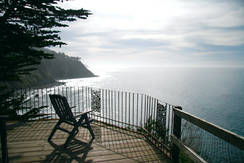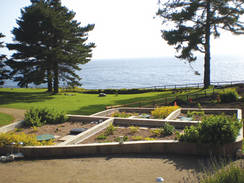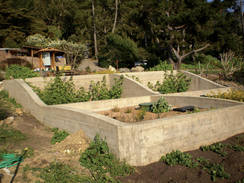PROJECT TYPE: Resorts / Retreats
SERVICE: Design-Build
TECHNOLOGY: Constructed Wetlands
SUSTAINABLE / WATER RE-USE: Landscape / Subsurface Irrigation; Sustainable Media/Natural Treatment
LOCATION: Big Sur, California
DESCRIPTION: IWS and Worrel Team Up to Design-Build First Living Machine in California
IWS was very responsive to our needs and worked well with our organization and personnel in completing the project on schedule and without disruption to our ongoing operations and programs at Esalen.
IWS partnered with Worrell Water Technologies, LLC (WWT) of Charlottesville, Virginia to complete the Design-Build of the first Tidal Wetland Living Machine® System (Living Machine ) in California at the Esalen Institute (Esalen) located in Big Sur, CA in January of 2008. The project resulted from Esalen’s search for a sustainable solution for its onsite wastewater needs that would integrate into its campus and philosophy.
The Living Machine
Living Machine systems are decentralized wastewater treatment systems that mimic processes found in wetland environments. The WWT patented technology uses mechanical and computer systems to enhance natural biological processes to treat wastewater. Living Machine systems provide a natural approach to wastewater treatment for communities, industries, academic institutions and government agencies. Using less energy than many other onsite wastewater treatment systems, Living Machine systems provide tertiary treatment, allowing the water to be reused for numerous applications including irrigation, toilet flushing, and wash water. Living Machine systems are frequently integrated into larger water reuse systems to increase water conservation, minimize wastewater surcharges, and meet operational requirements.
Esalen Institute
Esalen is a non-profit organization that has been devoted to the exploration of
human potential since the 1960’s. Historical luminaries like Aldous Huxley, Joseph Campbell, Jack Kerouac, Allen Ginsberg, Joan Baez, and countless others have gathered there to develop revolutionary ideas, transformative practices, and innovative art forms. Today Esalen is a retreat center where people come to attend educational seminar in a communal setting. Esalen Institute, renowned for its healing natural hot springs, has long been recognized as a world leader in alternative and experiential education. Now in its fifth decade, Esalen offers more than 500 public workshops and seminars a year, accenting personal growth and social change, in areas traditionally neglected by mainstream institutions.
Project Background
The Esalen campus original wastewater design utilized septic tanks discharging to traditional leachfields. Over time, some leachfields have failed and IWS and Worrel Team Up to Design-Build First Living Machine® in California The Living Machine integrated into the Esalen campus Overlooking the Pacific Ocean from Esalen Campus in Big Sur remaining leachfields are at risk of failure with untreated septic tank effluent with no replacement area available. Esalen looked at a variety of wastewater technologies, but settled on the Living Machine after considering sustainability, cost, discharge quality, aesthetics, and other factors important to their mission. The IWS and WWT team was selected to design and build the wetlands system based on past project performance.
System Design
The system was designed by Worrell Water Technologies under direction of
Senior Engineer, David Maciolek, P.E. and included pressure dosed leachfields.
IWS designed the drip dispersal system. Design flow was 7,000 gallons per day average flow with expansion capacity. The system included the following:
- The Living Machine was constructed on sloping terrain and is composed
of six concrete wetland cells, contoured and colored to conform to the
natural terrain. The cells are filled with a special aggregate media resting
on an underdrain system. Cell surfaces are planted with native wetland
type plants. - The system was designed and built to accommodate a phased expansion
of the facility and the treatment system. Future treatment capacity is expected to accommodate an additional 7,000 gallons per day of other onsite waste streams. - 500 linear feet of drip irrigation for landscaped areas with expansion planned.
- Pressure dose leach field to accept treated wastewater under a driveway area.
- Buried Fiberglass Tanks – 5,000 gallon Effluent Tank and a 10,000 gallon Primary and Equalization Tank.
- Computer control system with internet communication providing automated alerts, performance monitoring and remote control access for operators.
Project Challenges
The treatment system was constructed in the middle of the beautifully landscaped campus that had no room to spare. IWS provided security fencing and supported Esalen in establishing thoroughfares so that access to the Lodge, where most events and meals take place, was unrestricted. Esalen is a working and educational facility, set apart for not only learning, but for spiritual enrichment. IWS was sensitive to those requirements and our project team minimized interference with staff, students, and guests. The site for the Living Machine was adjacent to the organic garden, which provides much of the produce for the facility dinning operations. IWS was able to complete the construction with minimal impact to the gardening operations. Big Sur is a classic California Coastal environment, with heavy winter rains. IWS completed much of the work during the rainy season, which required erosion control and management. Additionally, IWS installed cutoff trenches to allow heavy runoff to be diverted around the Living Machine and tied into Esalen’s storm drains. As with many IWS projects, Esalen is in a relatively remote location, which means that planning and scheduling are critical. Material and equipment supplies were more than an hour away. WWT supplied ready- to-install electromechanical components including all pump stations, valve arrays, and controls system. IWS planned the project carefully and worked closely with Esalen staff to insure minimum disruption. WWT provided engineering support to streamline the project and assure maximum quality.
Successful Project
The Design and Construction of the project was a success, and was implemented on schedule and budget. Jake Hesse (Director of Operations) said “IWS was very responsive to our needs and worked well with our organization and personnel in completing the project on schedule and without disruption to our ongoing operations and programs at Esalen.” WWT provided comprehensive start-up and operator training services including extended operations support.
For more information, please click the ‘Contact’ tab to reach out to us. ,
![]()
download Tidal Wetland Living Machine installed at the Esalen Institute PDF



